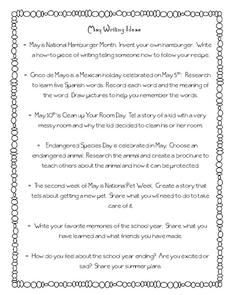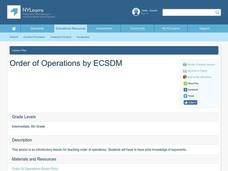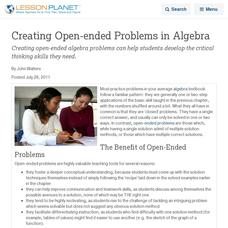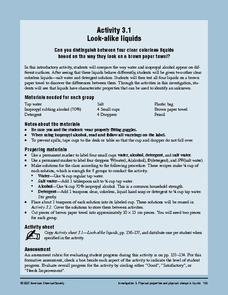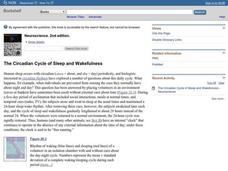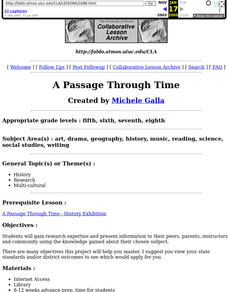Curriculum Corner
May Writing Ideas
From Cinco de Mayo to Endangered Species day to National Hamburger Month, May is full of ideas to write about. Give young writers prompts that have everything to do with the month of May. Topics include writing a story, conducting...
Curated OER
Order of Operations
Sixth graders are introduced to the concept of the orders of operations. The skills of using exponents are needed before trying the new concept. Students can be separated in groups for scaffolding.
Pimsleur
Food and Drink
Talk about healthy lifestyle choices... in Italian! Class members categorize food cutouts into a food pyramid and discuss why some items are healthier than others. The plan offers additional vocabulary reinforcement ideas for...
Curated OER
Order of Operations
Sixth graders participate in an introductory instructional activity on the order of operations. In this order of operations instructional activity, 6th graders watch a video clip and a SMART Notebook or PowerPoint presentation of the...
Curated OER
Creating Open-ended Problems in Algebra
Creating open-ended algebra problems can help students develop the critical thinking skills they need.
Curated OER
It's Not Just Story Time... It's Learning Time!
Students look at picture books and describe the story elements. In this picture book lesson, students retell a story and begin to understand the story elements of plot, setting, and characters. Students complete graphic organizers to...
Curated OER
G'Day Mate
Students understand that Australia is the smallest continent, locate it on a map and sing about the continents. In this Australia lesson, students listen to facts about Australia and complete a book about information they have learned.
Curated OER
Southern Literature
Study the literature of their region to make connections between the past and the present. Create and publish a regional magazine, which is filled with cultural events from the region.
American Chemical Society
Using Color to See How Liquids Combine
Blue-tinted water is added to unknown liquids that have been tinted yellow to find out how they interact. This is a memorable activity that is part of an investigation on the properties of liquids, which is part of a unit on the...
American Chemical Society
Using the Combining Test to Identify Unknown Liquids
Once investigators have learned how their mystery liquids interact with water during the preceding activity, they now use their observations to identify them. This is an ideal conclusion to the mini unit on the properties of water.
American Chemical Society
Look-Alike Liquids
Here is the first of four experiments to differentiate among unknown liquids by their behaviors and properties. Pupils observe how different liquids respond to being placed on plastic and paper, and they take notes about their...
Curated OER
Moose Juice
Math can be delicious with a fun smoothie worksheet! Kids count the number of fruits that go into a smoothie in an activity worksheet, draw the fruit in the blender, and complete the addition problem on the side. Each page increases in...
Royal Society of Chemistry
Mass Changes in Chemical Reactions—Microscale Chemistry
What better way is there to introduce conservation of mass than a few simple experiments? Young chemists conduct two chemical reactions, take the masses of reactants and products, then compare their results to determine...
Curated OER
Multiplication and Division Word Problems Made Easy
Marbles to learn math? What fun! Discuss the rules of multiplication and division when applied to whole numbers, decimals, and fractions. Small groups use6 marbles to design different types of multiplication and division problems, and...
Curated OER
Peace Corps Challenge Game- Food from Other Countries
Students examine traditional foods from other cultures. In this Peace Corps Challenge game, students research food preferences and delicacies in other countries and compare to the traditional American cuisine. Students...
Illustrative Mathematics
Making Hot Cocoa, Variation 2
Learners are introduced to dividing by fractions in a visual way. Setting up groups from the information in the problem allows them to see what we divide and why. Use with the previous lesson plan, which can be found in Additional...
Curated OER
Conejito
Third graders read the story "Conejito" and write a descriptive story about the rainforest in Panama. They answer story comprehension questions, complete worksheet questions about a map of Panama, and rewrite a paragraph changing the...
Curated OER
"The Drum"
Second graders read and discuss the folktale "The Drum" from India. They also answer story comprehension questions, complete an adjectives and verb worksheet, and label a map of India. Students sequence events from the story and make...
Charleston School District
Review Unit 4: Linear Functions
It's time to show what they know! An assessment review concludes a five-part series about linear functions. It covers all concepts featured throughout the unit, including linear equations, graphs, tables, and problem solving.
Curated OER
Sentence Completion 12: Low-Advanced SAT Level
Desiccate, despoil, devise, descry! You would be remiss if you did not use this sentence completion worksheet to challenge even your best pundits. The SAT level words and the beautifully detailed explanations key would help to ameliorate...
Curated OER
Aunt Sally Poster
Please Excuse My Dear Aunt Sally is the mnemonic device for the order of operations featured on an informative and engaging mathematic poster.
Curated OER
A Passage Through Time
Young learners research and present information about a chosen subject to their peers, parents, instructors, and community. This lesson has a strong research and public speaking component, and would be ideal for your higher level students.
Curated OER
Let Me Tell You About My State
State reports can be a lot of fun, especially when the learners get to choose the state they study. This research and writing-focused social studies lesson engages learners in collecting information, essay structure, research, and...
Curated OER
Modeling the Electromagnetic Spectrum
Learners construct a model of an electromagnetic spectrum using play-doh and string. They use exponents and plot the radio/microwave, infrared, and visible bandwidths of the spectrum.
